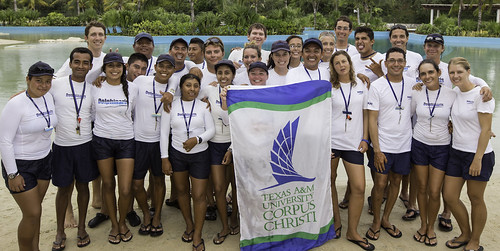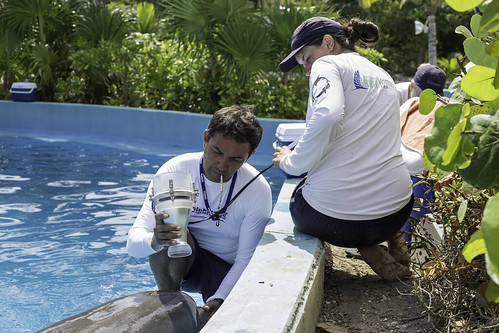Study Abroad Program Explores Dolphin Research, Science Communication
A group of Texas A&M University-Corpus Christi students spent the summer in Riviera Maya in the only program in the nation that blends dolphin research and hands-on animal care to become knowledgeable, effective science communicators who can share the importance of marine mammal health and a story of environmental conservation.

The program partners with Dolphinaris, an educational and interactive dolphin facility which emphasizes research and conservation. Student researchers work directly with Dolphinaris' dolphins and receive instruction from highly-skilled trainers and staff.
Researchers with the Comparative Physiology Laboratory in the College of Science and Engineering are focusing on lung function research, a specialty of the team, that gathers crucial data for dolphins in human care and in the wild.
"Lung problems are some of the most common causes of disease and death for wild dolphins, and what our students are learning and researching at Dolphinaris this summer is valuable for dolphin populations the world over," said Dr. Andreas Fahlman, Assistant Professor in the College of Science and Engineering.
"Lung function testing is a standard diagnostic tool in human respiratory medicine. With this we can look at the dolphins' lung functions in much the same way to study what is healthy for dolphins, and use that info for early detection of disease in both wild animals and animals in human care."

Researchers also expect to develop additional diagnostic tools that can assess dolphins in the wild. Such health assessments, much like a checkup a human would get at a doctor's office, are vital in providing a baseline of what is normal in a healthy population. The baseline information can be used to compare results from animals in distress, over time or in different geographic areas, a useful analysis for investigating whether man-made pollution is affecting an area.
Fahlman said he is amazed at the dolphins' respiratory capacity. He hopes that accurate knowledge of what causes disruptions in a dolphins' respiratory system will help us understand the environmental changes that could be affecting the number of dolphins in the wild.
The project also focuses on evaluating overall body condition of bottlenose dolphins to assess the health of dolphin populations in the wild.

Student researchers worked collaboratively with Dolphinaris trainers to collect aerial images in optimal conditions. From these images the researchers expect to be able to accurately determine the dolphin's length and width, which will tell about the animal's body condition.
This method can then be applied to wild dolphin populations to better assess health and make more informed efforts for dolphin conservation, Fahlman said.

Continued research in this area relies on finding healthy dolphins to study. That's where Dolphinaris plays a crucial role.
Dolphinaris first opened in 1999 in Cancun. The company has five facilities that house Atlantic, Pacific and Indo-Pacific bottlenose dolphins and the research done there provides important knowledge for dolphin populations worldwide.
The Riviera Maya facility opened in 2010, and has marine mammal specialists and a group of staff veterinarians on site that specialize in marine mammal medicine.
Student researchers in the program are also learning best practices in very innovative positive reinforcement training methods, hands-on care of marine mammals and how to communicate research results and conservation to a public that may know little about wildlife.
"Nowhere else could I get this kind of experience," said Danielle Kleinhenz, a graduate student, enrolled in the study abroad program. "Working with the dolphins every day, learning how to train them in a way that allows for data collection, and the chance to see up close how these creatures live and learn is extraordinary."
Marine mammal care is a very specialized field and A&M-Corpus Christi is the only university to offer this kind of program in this highly competitive field.
"The experience students gain from this program allows them to become better investigators as well as enable the students to bring a personal and well-informed perspective to a diverse international clientele when educating park guests at Dolphinaris," Fahlman said.
The 11 students in the program receive 5 class credits, and will earn a certificate of completion as a marine mammal specialist.
"This experience gives student's an edge over other people pursuing marine mammal studies or career paths," Fahlman said.
About the College of Science and Engineering: The College of Science and Engineering is preparing students in an array of life-changing studies such as aerodynamics, software development, genomics, and marine science. Engineering majors are finding solutions to problems using unmanned technologies. Marine scientists are working in the Gulf of Mexico and the Pacific to identify new species and harmful algal toxins. The University is also home to a nationally certified Computer Science program, the Plasma Engineering Research Lab, the nation's premier Geographic Information Sciences (GIS) program, and the Center for Coastal Studies.
About Texas A&M University-Corpus Christi: Offering more than 60 of the most popular degree programs in the state, Texas A&M-Corpus Christi has proudly provided a solid academic reputation, renowned faculty, and highly-rated degree programs since 1947. The Island University has earned its spot as a premier doctoral-granting institution, supporting two institutes and 13 research centers and labs. Discover your island at http://www.tamucc.edu/.
#StudyAbroadBecause
All photos and information contained herein courtesy and copyright Texas A&M University Corpus Christi.




















